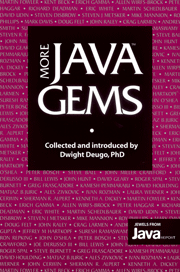Book contents
- Frontmatter
- Contents
- INTRODUCTION
- GETTING STARTED WITH JAVA
- MIGRATING TO JAVA
- TECHNIQUES 101
- MODELING AND PATTERNS
- JAVA IN A DISTRIBUTED WORLD
- THREADS
- USER INTERFACES
- SECURITY
- USING THE JAVASOFT SECURITY PACKAGE
- USING THE JAVA CRYPTOGRAPHIC EXTENSIONS
- JAVA APPLICATION SERVER SECURITY USING CAPABILITIES
- TESTING
- PERFORMANCE
- REALITY CHECK
- INDEX
JAVA APPLICATION SERVER SECURITY USING CAPABILITIES
Published online by Cambridge University Press: 06 July 2010
- Frontmatter
- Contents
- INTRODUCTION
- GETTING STARTED WITH JAVA
- MIGRATING TO JAVA
- TECHNIQUES 101
- MODELING AND PATTERNS
- JAVA IN A DISTRIBUTED WORLD
- THREADS
- USER INTERFACES
- SECURITY
- USING THE JAVASOFT SECURITY PACKAGE
- USING THE JAVA CRYPTOGRAPHIC EXTENSIONS
- JAVA APPLICATION SERVER SECURITY USING CAPABILITIES
- TESTING
- PERFORMANCE
- REALITY CHECK
- INDEX
Summary
The Internet has fostered rapid growth in the use of application servers. Previously inaccessible outside private Intranets, application servers are increasingly appearing as the middle layer of three-tiered network applications. A GUI executing on a desktop establishes a session with an application server that implements product features on top of a third tier of legacy systems or databases. Supported by growing customer access to the Internet, the application server allows a business to rapidly deploy information products, and services. Java catalyzes the process by speeding the development of both the GUI and server software as well as making the GUI platform-independent.
Application server development is a complex undertaking. Supporting simultaneous GUI connections, application servers must protect the integrity of system data from malicious clients and the privacy of clients from each other. Traditionally this has been accomplished by guarding sensitive data with access control checks. Associated with each protected object, an access control list (ACL) names authorized principals and permitted operations. The server checks the ACL before taking potentially damaging actions. Although this is called an access list approach, its essential characteristic is not the use of a list, but the checking of permissions after granting a reference to the protected object. In this approach, the reference does not imply a right to use the protected object.
Described here is an alternative way of protecting objects based on a capability approach.
- Type
- Chapter
- Information
- More Java Gems , pp. 323 - 336Publisher: Cambridge University PressPrint publication year: 2000



